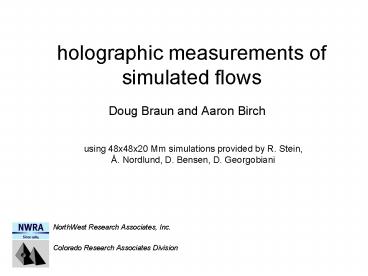holographic measurements of simulated flows
Title:
holographic measurements of simulated flows
Description:
... contributions from surface ( 2Mm) and below; both decrease rapidly with depth: ... this phase difference is equivalent to a travel-time perturbation: W. E. N. S ... –
Number of Views:27
Avg rating:3.0/5.0
Title: holographic measurements of simulated flows
1
holographic measurements of simulated flows
Doug Braun and Aaron Birch
using 48x48x20 Mm simulations provided by R.
Stein, Å. Nordlund, D. Bensen, D. Georgobiani
- NorthWest Research Associates, Inc.
- Colorado Research Associates Division
2
conclusions
- near-surface helioseismic holography (hh)
signatures are clearly correlated with mean
horizontal flows hh works - hh signatures focused below surface have equal
contributions from surface (lt2Mm) and below both
decrease rapidly with depth - surface contribution decreases due to
cancellation of signals from neighboring
convective cells (previously suspected and
modeled in solar SG) can cause reversal-like
signature - subsurface contributions decrease with ratio of
flow/sound-speed - assessment of noise with forward models
- flows like these can only be detected (at
resolutions of 6Mm) down to depths 5-7 Mm - deeper assessment of solar flows (like these) may
require combining many supergranules - these types of simulations are critical to
helioseismology
3
convective flows visible to p modes (8 hr
duration)
4
depth variations of mean (8-hr) flows
x
x
y
y
5
reversal at depth gt 12 Mm
slope velocities over near-surface values
6
helioseismic holography (hh) of flows
lateral vantage
N
E
W
S
H- ingression
H egression
7
hh of flows (continued)
N
W
E
S
in temporal Fourier domain, correlations between
egression and ingression are simply a product,
e.g. the E-W correlation is
the argument of the correlation averaged over a
frequency bandpass is a phase shift
the phase difference between E-W and W-E is
sensitive to a flow in x direction
this phase difference is equivalent to a
travel-time perturbation
8
power spectra
9
EW hh travel-time maps at different frequencies
3 mHz
4 mHz
mean
focus depth 0.7 Mm
5 mHz
6 mHz
mean velocity Vx (0.7 Mm)
10
hh calibrated flows
- calibration constant determined by introducing a
known tracking rate - different calibration for each frequency bandpass
- average 3,4,5, and 6 mHz bandpasses
- resulting velocities represent weighted average
over depth
11
8-hr mean flows at 0.7 Mm (smoothed to FWHM 6
Mm)
hh calibrated flows, focus 0.7 Mm
Ux
Vx
X
Uy
Vy
y
12
hh travel-time maps vs. focus depth
travel-times, focus 0.7 Mm
focus 0.7 7 Mm
EW
NS
13
decrease of hh travel-time signatures
- ratio of signatures to surface values fall-off
faster than actual flow speed ratios - effects of lower boundary impede measurements at
and below 8 Mm - possible reversal in NS signature below 6 Mm
slope travel times over near-surface values
14
reversal of supergranular hh signatures
div vh pupil
v e-z/zo cos(?z/z1) zo 2.5 Mm. red crosses
no return flow (z1 ??). green circles z1 5 Mm
black diamonds z1 15 Mm.
(Braun, Birch, Lindsey 2004 SOHO/GONG
Proceedings)
15
observed vs. forward-modeled hh travel times
obs
model
obs-model
depth 3Mm
3 mHz
r.m.s. 10 s
3-6 mHz
r.m.s 5 s
16
assessment of relative depth contributions
depth 3 Mm
lt 2 Mm
gt 2 Mm
total
17
depth 5 Mm
lt 2 Mm
gt 2 Mm
total
18
depth 7 Mm
lt 2 Mm
gt 2 Mm
total
19
signal-to-noise
depth r.m.s signal (subsurface only for gt 2 Mm) S/N (8 hr) S/N (24 hr)
0.7 Mm 22 s 4.8 8.1
3 Mm 7.8 s 1.7 2.9
5 Mm 5.1 s 1.1 1.9
7 Mm 3.5 s 0.8 1.3
- assumes these flows are typical of Sun
- assumes smearing of 6Mm can sacrifice spatial
resolution to increase S/N - assumes only 3-5 mHz for Sun (not 3-6 mHz)
- assumes good assessment of shallower contributions
20
conclusions
- near-surface helioseismic holography (hh)
signatures are clearly correlated with mean
horizontal flows hh works - hh signatures focused below surface have equal
contributions from surface (lt2Mm) and below both
decrease rapidly with depth - surface contribution decreases due to
cancellation of signals from neighboring
convective cells (previously suspected and
modeled in solar SG) can cause reversal-like
signature - subsurface contributions decrease with ratio of
flow/sound-speed - assessment of noise with forward models
- flows like these can only be detected (at
resolutions of 6Mm) down to depths 5-7 Mm - deeper assessment of solar flows (like these) may
require combining many supergranules - these types of simulations are critical to
helioseismology































